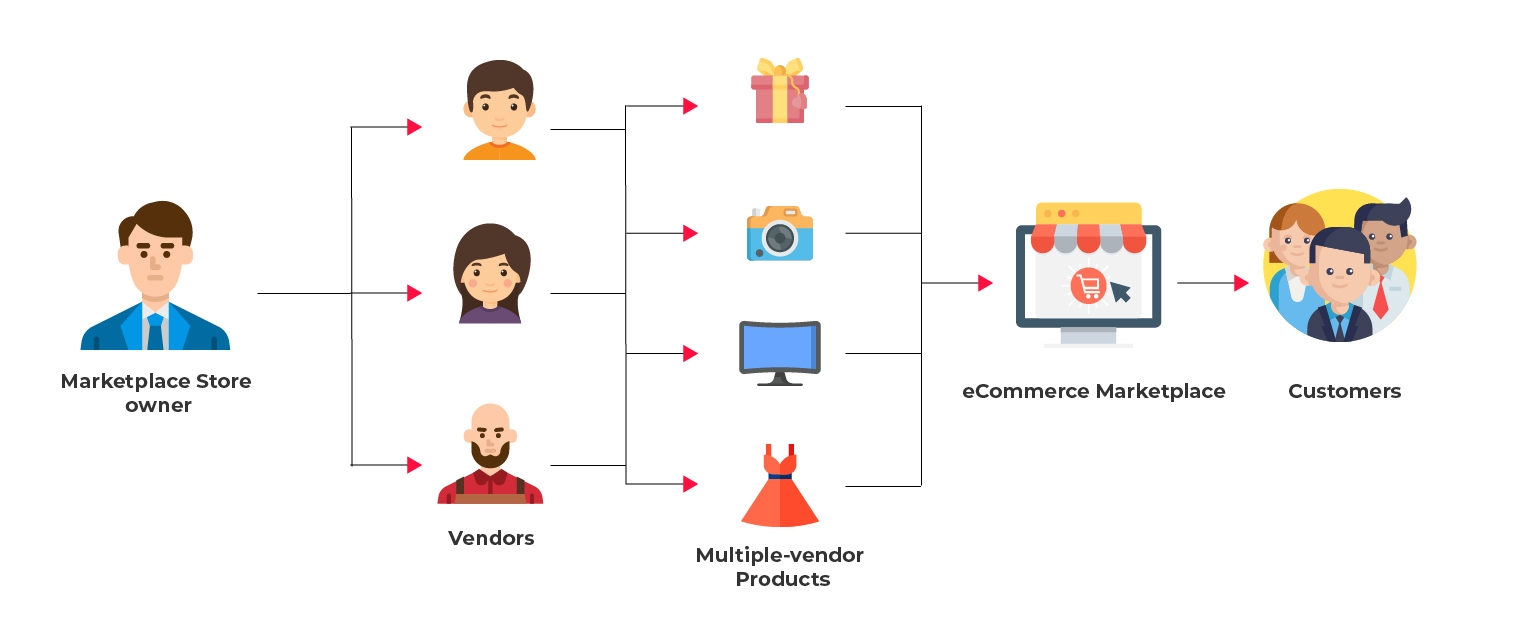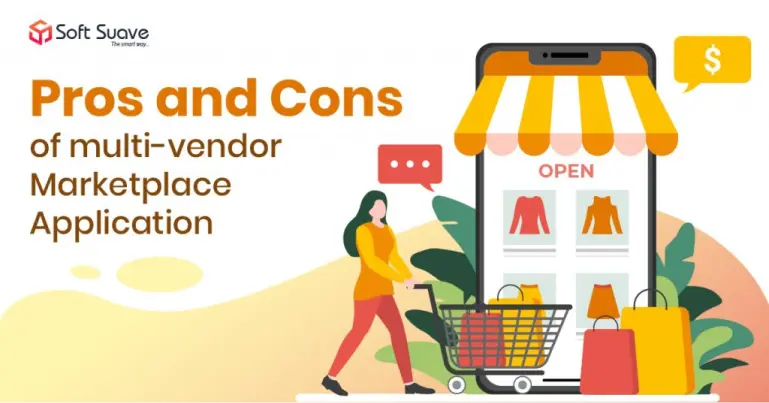Multi-vendor marketplace app is a platform that will let several sellers connect with potential buyers. This has transformed into an efficient business model and enabled businesses who don’t have a product or service to sell to get into the eCommerce train. Here, the one who owns and manages the marketplace is more of a facilitator as they only provide a platform that connects businesses and customers.
The online marketplace application is basically an online equivalent of a mall. Just like how a mall houses the stores of best brands which inturn brings in customers in huge volume, the online marketplace also attracts a lot of digital shoppers.
The Multi-vendor Marketplace Platform involves 3 parties namely buyers, sellers and the facilitator of the marketplace themselves with each having their own sets of pros and cons. This blog will talk about the factors each party gains and losses.

Seller:
The seller could be anyone ranging from a small entrepreneur selling homemade artifacts to large corporates who do mass production of their products. This platform gives them all a portal to sell their products with ease.
Pros:
1. Wide range of customers
Just like how a mall will have more footfall than a stand-alone brick and mortar store, the Multi-vendor eCommerce marketplace platform too will attract more users than an individual brand-specific eCommerce app. This is due to the fact that there are more products available here.
2. Equal Market Opportunity
Both the small and big businesses will get equal market share here and this creates a competitive environment. The nature of the eCommerce business also ensures that big sharks don’t eat the small fishes in this vast ocean.
3. Access to new markets
The beauty of a Multi-vendor marketplace software is that it connects buyers and sellers across the globe. A University student in Cincinnati can buy a hand crafted wooden pen made by a tribe woman from the Masai clan in Tanzania.
4. Ease of Marketing
The sellers don’t need to shell out big bucks for the purpose of marketing their product. Having their product listed in the platform will itself act as a mode of marketing for it.
5. Hassle free shipping
Since the owner of the platform will do the shipping themselves or have tie-ups with established third party logistics companies, shipping and processing the return of products will be upon them.
Cons:
1. Commission fee to the owner of the marketplace
The buyer needs to pay a small part of the revenue to the marketplace whenever a purchase is made, the commission is not applicable when sellers sell from their own app.
2. Control over the selling cost
Here the selling cost of a product is decided by the market factors and they can’t quote the price that they would deem fit unless it is the same as the one denoted by the market
Consumer:
The consumers are the most important aspects to any business and it holds true to this model of business as well.
Pros:
1. Extended range of products
The Multi-vendor marketplace software is basically a shopaholics delight as they will be treated to a wide catalogue of brands and products empowering them a freedom of choice.
2. Exclusive deals
Both the sellers as the multi market place will run attractive deals from time to time which is a great advantage to the consumer as they are the ones who will be at the receiving end of all these deals.
3. Ease of finding alternate products
If they are not able to find a product they are looking for, an alternate product will be suggested to them thanks to the advanced algorithm employed by the application developers.
Cons:
1. Lack of personalized products
Imagine a consumer come across a watch and would like to have the names of their loved ones engraved on it. While it is completely possible in a stand alone eCommerce store or a physical store, it is not as easy in a multi vendor platform
2. Subjection to manipulation
There is a possibility of the consumer to be manipulated and made to purchase things they don’t want. This can be done by placing attractive ads or over the top discount deals.
Owner:
The owner of the Multi-vendor e-commerce marketplace does a great job by acting as a bridge that connects vendors and consumers.
Pros:
1.Easy to scale
This is a business model that mainly relies on the efficiency of operations rather than investment for the purpose of scaling. Even Though the investment plays a huge role in scaling, it comes only second.
2.No need to maintain an active inventory
As they act just as middle men there is no need for them to maintain an active inventory to satisfy the demands of the consumers.
3. Commission based business model
The mode of revenue in this business is the commission from the sales made by the vendor so the owner need not worry about margins
4. Cost Effective
This is one of the most cost effective business models with a great return on investment.
Cons:
1. Hassles of shipping and return
The onus of shipping a product from the vendor to the customer or the vice versa in case of a return order is on the owner. This can be a huge logistical nightmare; however, employing third party delivery partners can give some space to breath.
2. Legal and tax compliance's
This is a business that will spread across the globe with each country having its own set of tax and legal guidelines. The Multi-vendor marketplace app will need to adhere to all the norms set by the global government in order to have a streamlined operation.
Conclusion:
While this model has its own set of flaws, it is however, overweight by the advantages involved thus empowering all the three parties involved in a win-win situation. The fact that there is a huge surge in the usage of free multi vendor marketplace is proof that this is a successful model and is here to stay. The future of it also looks confident with more businesses vying this method rather than going for an individual eCommerce platform for their business. Red tapism has been one of the major hassles for it and if it can be negated in the future, we can achieve a global marketplace.
Madhu, the adept Project Manager at Soft Suave Technologies, ensures successful project delivery with a strategic mindset and commitment to excellence. Skilled in frontend (React, Angular) and backend (Node.js, Python) technologies, his leadership fosters continuous improvement. Connect with Madhu to explore how Soft Suave’s projects excel under his guidance.


